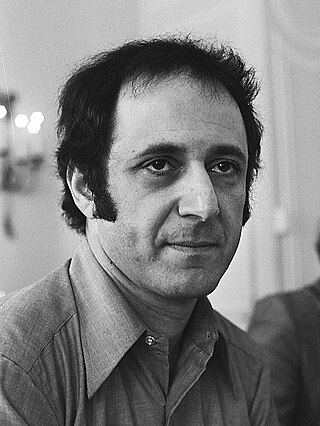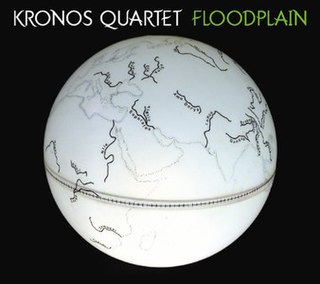
In music, an arrangement is a musical adaptation of an existing composition. Differences from the original composition may include reharmonization, melodic paraphrasing, orchestration, or formal development. Arranging differs from orchestration in that the latter process is limited to the assignment of notes to instruments for performance by an orchestra, concert band, or other musical ensemble. Arranging "involves adding compositional techniques, such as new thematic material for introductions, transitions, or modulations, and endings. Arranging is the art of giving an existing melody musical variety". In jazz, a memorized (unwritten) arrangement of a new or pre-existing composition is known as a head arrangement.
In music, a quartet is an ensemble of four singers.

Stephen Michael Reich is an American composer who is known for his contribution to the development of minimal music in the mid to late 1960s. Reich's work is marked by its use of repetitive figures, slow harmonic rhythm, and canons. Reich describes this concept in his essay, "Music as a Gradual Process", by stating, "I am interested in perceptible processes. I want to be able to hear the process happening throughout the sounding music." To do so, his music employs the technique of phase shifting, in which a phrase is slightly altered over time, in a flow that is clearly perceptible to the listener.

The term string quartet can refer to either a type of musical composition or a group of four people who play them. Many composers from the mid-18th century onwards wrote string quartets. The associated musical ensemble consists of two violinists, a violist, and a cellist.

Chamber music is a form of classical music that is composed for a small group of instruments—traditionally a group that could fit in a palace chamber or a large room. Most broadly, it includes any art music that is performed by a small number of performers, with one performer to a part. However, by convention, it usually does not include solo instrument performances.

George Henry Crumb Jr. was an American composer of avant-garde contemporary classical music. Early in his life he rejected the widespread modernist usage of serialism, developing a highly personal musical language which "range[s] in mood from peaceful to nightmarish". Crumb's compositions are known for pushing the limits of technical prowess by way of frequent use of extended techniques. The unusual timbres he employs evoke a surrealist atmosphere which portray emotions of considerable intensity with vast and sometimes haunting soundscapes. His few large-scale works include Echoes of Time and the River (1967), which won the 1968 Pulitzer Prize for Music, and Star-Child (1977), which won the 2001 Grammy Award for Best Contemporary Classical Composition; however, his output consists of mostly music for chamber ensembles or solo instrumentalists. Among his best known compositions are Black Angels (1970), a striking commentary on the Vietnam War for electric string quartet; Ancient Voices of Children (1970) for a mixed chamber ensemble; and Vox Balaenae (1971), a musical evocation of the humpback whale, for electric flute, electric cello, and amplified piano.
The Duke Quartet is a contemporary string quartet based in Europe. Its members are Louisa Fuller (violin), Rick Koster (violin), John Metcalfe (viola), and Sophie Harris (cello).

The Kronos Quartet is an American string quartet based in San Francisco. It has been in existence with a rotating membership of musicians for almost 50 years. The quartet covers a very broad range of musical genres, including contemporary classical music. More than 1,000 works have been written for it.
Osvaldo Noé Golijov is an Argentine composer of classical music and music professor, known for his vocal and orchestral work.

The String Quartet No. 14 in D minor, D 810, known as Death and the Maiden, is a piece by Franz Schubert that has been called "one of the pillars of the chamber music repertoire". It was composed in 1824, after the composer suffered a serious illness and realized that he was dying. It is named for the theme of the second movement, which Schubert took from a song he wrote in 1817 of the same title. But, writes Walter Willson Cobbett, all four movements of the quartet are welded "into a unity under the pressure of a dominating idea - the dance of death."
Black Angels may refer to:
Bent Sørensen is a Danish composer. He won the prestigious Grawemeyer Award for Music Composition in 2018 for L'isola della Città (2016).
Peter Wentworth Bucknell is a filmmaker, author and classical violist residing in Barcelona.

Black Angels is a 1990 album by the string quartet Kronos Quartet. It includes, and was named after, George Crumb's 1970 composition Black Angels, the composition which had inspired David Harrington to found the Kronos Quartet in 1973.

The Miró Quartet is an internationally performing professional classical string quartet based in Austin, Texas. The group is the Quartet-in-Residence at the University of Texas and its members are on the faculty of the Butler School of Music. Its members are Daniel Ching, violin; William Fedkenheuer, second violin ; John Largess, viola; and Joshua Gindele, cello.

Floodplain is a studio album by the Kronos Quartet released in 2009. All twelve compositions were written or arranged for the quartet.

Early Music is a studio album by the Kronos Quartet, containing 21 compositions, many of which were written, arranged, or transcribed for the quartet. The subtitle is from Dowland's Lachrimae, or Seaven Teares of 1604.
This is a Nonesuch Records discography, organized by catalog number.
Christine Southworth is an American composer of postminimal music and works with combinations of Western ensembles, electronics, and world music ensembles including Balinese gamelan and bagpipes. She performs Balinese gamelan and gender wayang with Cambridge, Massachusetts-based Gamelan Galak Tika, as well as Galician Gaita and Great Highland Bagpipes. She co-founded Ensemble Robot, a cooperative of engineers, artists and musicians working together to invent robotic musical instruments. She was also the general manager of Gamelan Galak Tika from 2004 through 2013. Her own music incorporates her work with Balinese gamelan and with technology and electronics, as well as reaching beyond these influences with an expanded palette of contemporary classical, jazz and rock, and world music from Africa, Asia and Eastern Europe.

Gideon Gee-Bum Kim is a Korean-Canadian classical music composer, conductor, and music educator and founder of the Toronto Messiaen Ensemble. His music draws on his Christian faith and shows a connection of the rich musical heritage of Korea and new compositional techniques, especially in the field of heterophony texture and all of this with live and emotional imagination.












